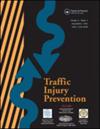A study on lane-changing risk evolution of vehicle group based on potential field model in the freeway tunnel approach section
IF 1.6
3区 工程技术
Q3 PUBLIC, ENVIRONMENTAL & OCCUPATIONAL HEALTH
引用次数: 0
Abstract
Objective
In the freeway tunnel approach section, lane-changing behaviors and transitions in the driving environment exacerbate traffic flow disruptions, increase driving risks, and lead to a higher accident rate. To this end, this study presents a method to explore the risk evolution process of lane-changing in these sections and evaluate its impact on traffic flow operations surrounding lane-changing vehicles.
Methods
First, a driving risk potential field model based on the field theory, which consists of a vehicle kinetic potential field and a tunnel illumination potential field, is proposed to evaluate the driving risk. Furthermore, a “vehicle group” risk graph was constructed based on graph theory, incorporating both a node-coupling driving risk model and a topological potential entropy model. Finally, trajectory datasets were collected through naturalistic driving tests to analyze the evolution of lane-changing risk and the stability of the vehicle group.
Results
From the analysis of coupling driving risk evolution, we found that in the [100, 500) m, [500, 1000) m, and [1000, 1500) m freeway tunnel approach sections, the coupled driving risk of lane-changing vehicle (LCV) was higher than that of the other vehicles in the vehicle group. In different tunnel approach sections, LCVs that received the highest risk were from different vehicles in vehicle group. LCVs received the highest field strength from the risk potential fields of the lateral vehicle (LV), front lateral vehicle (FLV), and front vehicle (FV) in the [100, 500) m, [500, 1000) m, [1000, 1500) m tunnel approach sections, respectively. Based on the absolute value of the vehicle group topological potential entropy, we observed the resilience of the vehicle group system improved with increasing distance from the tunnel entrance. Traffic flow regained stability more quickly after lane-changing disturbances in sections farther from the tunnel entrance.
Conclusions
This study highlights that the section closer to the freeway tunnel entrance significantly impact lane-changing risk, and it takes longer for the vehicle group to recover its stability after a lane-changing disturbance. The research results offer a theoretical and methodological foundation for enhancing traffic safety measures and developing microscopic driving behavior models for freeway tunnel approach sections.
基于势场模型的高速公路隧道进场段车辆群变道风险演化研究。
目的:在高速公路隧道进路路段,行车环境中的变道行为和转变加剧了交通流中断,增加了行车风险,导致事故率升高。为此,本研究提出了一种探索这些路段变道风险演化过程的方法,并评估其对变道车辆周围交通流运行的影响。方法:首先,基于场论,建立由车辆动力势场和隧道照明势场组成的行车风险势场模型,对行车风险进行评估;在此基础上,结合节点耦合驱动风险模型和拓扑势熵模型,构建了“车辆群”风险图。最后,通过自然驾驶测试收集轨迹数据集,分析变道风险的演变和车辆群的稳定性。结果:通过耦合驾驶风险演化分析发现,在[100,500)m、[500,1000)m和[1000,1500)m高速公路隧道进路路段,变道车辆(LCV)的耦合驾驶风险高于车辆组中其他车辆。在不同的隧道进路路段,风险最高的轻型货车来自不同的车辆组。lcv分别在[100、500)m、[500、1000)m、[1000、1500)m隧道进近路段受到横向车辆(LV)、前横向车辆(FLV)和前车辆(FV)风险势场的场强最大。基于车辆群拓扑势熵的绝对值,我们观察到车辆群系统的弹性随距离隧道入口的增加而提高。在远离隧道入口的路段,在变道干扰后,交通流量恢复稳定的速度更快。结论:研究表明,靠近高速公路隧道入口的路段对变道风险有显著影响,且车队在受到变道干扰后恢复稳定所需时间较长。研究结果为加强高速公路隧道引道段交通安全措施和建立微观驾驶行为模型提供了理论和方法依据。
本文章由计算机程序翻译,如有差异,请以英文原文为准。
求助全文
约1分钟内获得全文
求助全文
来源期刊

Traffic Injury Prevention
PUBLIC, ENVIRONMENTAL & OCCUPATIONAL HEALTH-
CiteScore
3.60
自引率
10.00%
发文量
137
审稿时长
3 months
期刊介绍:
The purpose of Traffic Injury Prevention is to bridge the disciplines of medicine, engineering, public health and traffic safety in order to foster the science of traffic injury prevention. The archival journal focuses on research, interventions and evaluations within the areas of traffic safety, crash causation, injury prevention and treatment.
General topics within the journal''s scope are driver behavior, road infrastructure, emerging crash avoidance technologies, crash and injury epidemiology, alcohol and drugs, impact injury biomechanics, vehicle crashworthiness, occupant restraints, pedestrian safety, evaluation of interventions, economic consequences and emergency and clinical care with specific application to traffic injury prevention. The journal includes full length papers, review articles, case studies, brief technical notes and commentaries.
 求助内容:
求助内容: 应助结果提醒方式:
应助结果提醒方式:


